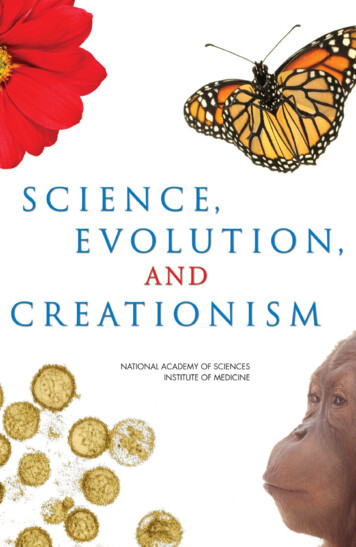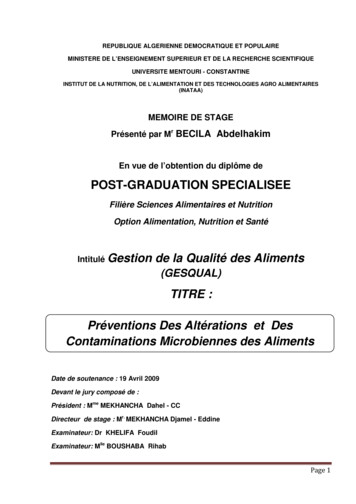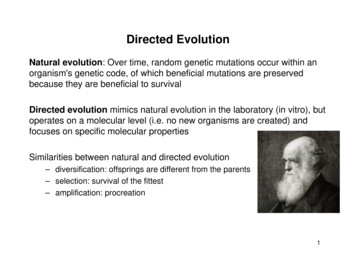
Transcription
Why Is Evolution Important?The discovery and understanding of the processes of evolution represent one of the mostpowerful achievements in the history of science. Evolution successfully explains the diversity oflife on Earth and has been confirmed repeatedly through observation and experiment in a broadspectrum of scientific disciplines.Evolutionary science provides the foundation for modern biology. It has opened the door toentirely new types of medical, agricultural, and environmental research, and has led to the development of technologies that can help prevent and combat disease. Regrettably, effective scienceeducation in our schools is being undermined by efforts to introduce non-scientific conceptsabout evolution into science classrooms.How Science WorksThe study of evolution provides an excellent example of how scientists go about their work. Theyobserve nature and ask testable questions about the natural world, test those questions throughexperiment and new observations, and construct explanations of evolution based on evidence.As scientists gather new results and findings, they continue to refine their ideas. Explanations arealtered or sometimes rejected when compelling contradictory evidence comes to light.Some scientific explanations are so well established that nonew evidence is likely to alter them. The explanation becomesa scientific theory. In everyday language a theory means ahunch or speculation. Not so in science. In science, the wordtheory refers to a comprehensive explanation of an importantfeature of nature that is supported by many facts gathered overtime. Theories also allow scientists to make predictions aboutas yet unobserved phenomena.A good example is the theory of gravity. After hundreds ofyears of observation and experiment, the basic facts of gravityare understood. The theory of gravity is an explanation of thosebasic facts. Scientists then use the theory to make predictionsabout how gravity will function in different circumstances. Suchpredictions have been verified in countless experiments, furtherconfirming the theory. Evolution stands on an equally solid foundation of observation, experiment, and confirming evidence.Evolution Has Been Repeatedly Tested and ConfirmedWe all know from our experience that biological traits pass from parents to offspring. Sometimestraits change between generations. If a new trait results in an offspring doing better in its naturalsurroundings and producing more offspring that also inherit the trait, that trait will become morewidespread over time. If the new trait makes the offspring less able to survive and thus leave feweroffspring, the trait will tend to fade from existence. Natural selection is the process by which sometraits succeed and others fail in the environment where the organism lives. For every type of lifewe see today, there were many other types that were unsuccessful and became extinct.Scientists no longer question the basic facts of evolution as a process. The concept has withstood extensive testing by tens of thousands of specialists in biology, medicine, anthropology,geology, chemistry, and other fields. Discoveries in different fields have reinforced one another,and evidence for evolution has continued to accumulate for 150 years.
The Fossil Record The concept of evolutionis supported by fossil findings in rock layers from different ages of Earth’s history. In general, fossils thatmore closely resemble today’s life forms are found inyounger rock layers, while many fossils that only distantly resemble life today occur in older layers. Basedon such findings, naturalists proposed that specieschange, or evolve, over time. Natural selection has beenidentified as a driving force behind these changes. Sincethen, scientists have found an overwhelming numberof fossils in rock layers of different ages that repeatedly A near complete skeleton of a transitional bird-likeconfirm the changes in life forms that are predicted by fossil discovered in China and reported in 2006.the theory of evolution.DNA Research Molecular biology and genetics have revealed how evolution works at thelevel of molecules. Unknown when evolution and natural selection were first proposed in 1859,genetics has shown that traits are passed from parent to offspring through DNA, a molecule in allliving things that directs how cells grow and reproduce. DNA studies support findings from otherbranches of science. For example, species that appear to be more distantly related from their positionsin the fossil record are found to have correspondingly greater differences in their DNA than species thatappear more closely related in the fossil record.gorilla Ahuman CCTCATCAAGACAATTGTCACCAGGhuman CAAACAGAAGGTCACCGGTTTGGACgorillagorillaGChuman CAAGATGGACCAGACACTGGCAGTChuman CATGATCCAAATATCCAACGACCTGgorilla Ahuman CTCTAAGAGCTGCCACTTGCCCTGGgorillaCComparison of the human and chimp DNA sequences for the gene that encodes the hormone leptin (which isinvolved in the metabolism of fats) reveals only five differences in 250 nucleotides. Where the human and chimpanzee sequences differ, the corresponding nucleotide in the gorilla (shaded bars) can be used to derive the nucleotidethat likely existed in the common ancestor of humans, chimpanzees, and gorillas. In two cases, the gorilla andhuman nucleotides match, while in the other three cases, the gorilla and chimpanzee sequences are the same. Thecommon ancestor of the gorilla, chimpanzee, and human is most likely to have had the nucleotide that is the samein two of the three modern-day organisms because this would require just one DNA change rather than two.
TIKTAALIKA Case Study in Scientific PredictionUsing the principles of evolution, scientists have been able to predict what new fossils might be discovered. For example, scientists had found fossils of ancient fish that lived in shallow waters in earliertimes and fossils of four-limbed land dwellers that appeared later in time. What happened in between?Evolutionary theory predicts that there would be creatures with characteristics of both the ancientfish and the later land-dwellers. A team of scientists decided to look in sedimentary rock in northernCanada that was deposited about 375 million years ago, about the time these intermediate specieswere thought to have lived, based on other evidence from the fossil record.In 2004, the team found what they had predicted: the fossil of a creature with features of fish(scales and fins) and features of land-dwellers (simple lungs, flexible neck, and fins modified tosupport its weight). The bones in the limbs of this fossil, named Tiktaalik, resemble the bones in thelimbs of land-dwelling animals today.By understanding evolution, scientists were able to predict what type of creature existed and inwhat geologic layer it would be found. The discovery of Tiktaalik fills another gap in the fossil record.Paleontologists searched this remote valley in north centralCanada for a species intermediate between fish and limbedanimals capable of living on land because they knew thesedimentary rocks there were deposited during the periodwhen such a transition was hypothesized to have taken place.site of fossilsTiktaalik’s left and right fins hada single upper bone (the largebone at the bottom of each ofthese drawings) followed by twointermediate bones, giving thecreature an elbow and a wrist,as in more recent organisms.Tiktaalik and other fossil intermediates between fish and tetrapods. These fossilsrepresent an assortment of species that lived between 385 and 359 million yearsago, spanning the evolution of fish to amphibians.
Common Ancestry There are commonstructures and behaviors among many species. A person writes, a cow walks, a whale swims, and a batflies with structures built of bones that are differentin detail but also remarkably similar to each other.When fossils are compared to one another in structure and in age, it becomes clear that an ancestralspecies gave rise to an array of successor specieswith the same basic arrangement of limb bones. Asnew findings have repeatedly demonstrated, for anytwo species living today, their evolutionary lines canbe traced back in time until the two lines intersect ina common ancestor.The fossil record, DNA research, the evidence thatspecies have common ancestors, and other findingsadd up to overwhelming evidence that evolutionby natural selection is how life on Earth arose andbecame sPhalangesWhaleThe bones in theforelimbs of terrestrial and someaquatic vertebratesare remarkablysimilar becausethey have allevolved from theforelimbs of acommon ancestor.BirdNature imposes a direction to evolutionary development. Though dolphins (left) are more closely related to humansthan they are to sharks (right), they have evolved bodies adapted to an aquatic environment.Creationism Does Not Belongin the Science ClassroomSome people argue that the diversity of life did not evolve through natural processes. They advocate that creation be added to the school science curriculum alongside biological evolution.But creationism is not science. Creationist arguments are based on beliefs about an entityoutside the natural world. But science can only investigate naturally occurring phenomena. Infact, the many questions about evolution raised by creationists are readily answered by availableand accumulating scientific evidence. For example: Creationists argue that the theory of evolution is faulty because of gaps in the fossil record.(Creationists identify as gaps those situations where intermediate fossil forms between two relatedspecies are as yet undiscovered.) But an increasing number of intermediate forms have been andcontinue to be found. Even without actual fossils in hand, scientists can use modern techniques in
molecular biology and genetics along with the principlesof evolution to infer what forms of life existed and predictwhere and what kinds of fossils will likely be found. Some creationists claim that certain features of livingbeings are too complex to have evolved through naturalprocesses. They claim that structures such as a bacterium’sflagellum (the hair-like part that gives the bacterium motion),the human eye, or the immune system are “irreducibly complex” and must have been created intact by an “intelligentdesigner.” But biologists have discovered that components ofthe flagellum have their own individual functions and alsohave found intermediate forms of flagella. Both of those findings support the idea of the flagellum evolving from existingstructures over time. Also, the creationist argument that suchfeatures “must” have been designed is based on their preconceived idea of a Creator, while the scientific position is basedon observable facts and falsifiable explanations.Electron micrograph of a bacteriumwith hair-like flagella. Some creationists argue based on scripture that the Earth cannot be old enough for thediversity of life to have emerged through evolution. Yet measurements from geology, astronomy, and other fields have repeatedly confirmed the ancient age of the Earth (approximately4.5 billion years).Because science has no way to accept or refute creationists’ assertions, creationist beliefsshould not be presented in science classrooms alongside teaching about evolution. Teachingnon-scientific concepts in science class will only confuse students about the processes,nature, and limits of science.Science and Religion Offer Different Ways ofUnderstanding the WorldScience and religion address separate aspects of human experience.Many scientists have written eloquently about how their scientific studies of biologicalevolution have enhanced rather than lessened their religious faith. And many religiouspeople and denominations accept the scientific evidence for evolution.Our education system and our society as a whole are best served when we teach science,not religious faith, in science classrooms.
EVOLUTION IN ACTIONMedicine’s Challenge in Countering Resistant Strainsof Harmful BacteriaIn late 2002, several hundred people in China came down with a severe form of pneumonia caused by an unknown infectious agent. Dubbed “severe acute respiratory syndrome,”or SARS, the disease soon spread to Vietnam, Hong Kong, and Canada and led to hundreds of deaths. In March 2003, a team of researchers at the University of California, SanFrancisco, received samples of a virus isolated from the tissues of a SARS patient. Using anew technology known as a DNA microarray, the researchers compared the genetic material of the unknown virus with that of known viruses. Within 24 hours, they assigned thevirus to a particular family based on its evolutionary relationship to other viruses—a resultconfirmed by other researchers using different techniques. Immediately, work began on ablood test to identify people with the disease (so they could be quarantined), on treatmentsfor the disease, and on vaccines to prevent infection with the virus.Understanding the evolutionary origins of human pathogens will become increasinglyimportant as new threats to human health arise. For example, many people have sufferedfrom severe medical problems as bacteria have evolved resistance to antibiotics. When abacterium undergoes a genetic change that increases its ability to resist the effects of anantibiotic, that bacterium can survive and produce more copies of itself while non-resistant bacteria are being killed. Bacteria that cause tuberculosis, meningitis, staph infections(sepsis), sexually transmitted diseases, and other illnesses have evolved resistance to anincreasing number of antibiotics and have become serious problems throughout the world.Knowledge of how evolution leads to increased resistance will be critical in controllingthe spread of infectious diseases.
The content of this informational brochure was adapted from the full-length,88-page version of Science, Evolution, and Creationism (2008), produced by acommittee of the National Academy of Sciences and the Institute of Medicine.This brochure and the full-length report on which it is based are available fordownloading and ordering at http://www.nap.edu/sec.AUTHORING COMMITTEEFRANCISCO J. AYALA, Chair, University of California, Irvine*BRUCE ALBERTS, University of California, San Francisco*MAY R. BERENBAUM, University of Illinois, Urbana-Champaign*‡BETTY CARVELLAS, Essex High School (Vermont)MICHAEL T. CLEGG, University of California, Irvine*‡G. BRENT DALRYMPLE, Oregon State University*ROBERT M. HAZEN, Carnegie Institution of WashingtonTOBY M. HORN, Carnegie Institution of WashingtonNANCY A. MORAN, University of Arizona*GILBERT S. OMENN, University of Michigan†ROBERT T. PENNOCK, Michigan State UniversityPETER H. RAVEN, Missouri Botanical Garden*BARBARA A. SCHAAL, Washington University in St. Louis*‡NEIL deGRASSE TYSON, American Museum of Natural HistoryHOLLY WICHMAN, University of Idaho*Member, National Academy of SciencesMember, Institute of Medicine‡Member, Council of the National Academy of Sciences†Photo and Illustration Creditst top; b bottom; l left; r rightFront Cover (tl) red chrysanthemum, Stockbyte; (tr) Monarch butterfly, DonFarrall/Photographer’s Choice; (bl) Sin Nombre virus particles at 171,000 magnification, Digital Stock; (br) orangutan,Ryan McVay; Panel 1 lunar rover, NASA; Panel 2 airplane passengers, Reuters/Corbis; Panel 3 transitional bird-like fossil,courtesy Hailu You, Chinese Academy of Geological Sciences; Panel 4 (tl) Nunavut valley, Ted Daeschler/Academy ofNatural Sciences/VIREO; (tr) drawing of Tiktaalik fin skeleton, Kalliopi Monoyios; (bl) Tiktaalik fossil, Shubin Lab,University of Chicago; Panel 5 (l) dolphins, Captain Budd Christmann, NOAA Corps; (r) great white shark, OxfordScientific/Photolibrary; Panel 6 (tr) H. Pylori bacterium with flagella, Visuals Unlimited/Corbis; (b) view of Earth, Photodisc.The National Academy of Sciences is a private, nonprofit, self-perpetuating society to whichdistinguished scholars are elected for their achievements in research, and is dedicated to thefurtherance of science and technology and to their use for the general welfare. Upon theauthority of the charter granted to it by the Congress in 1863, the Academy has a mandate toadvise the federal government on scientific and technical matters.The Institute of Medicine was established in 1970 by the National Academy of Sciences asboth an honorific and a policy research organization, to which members are elected on thebasis of their professional achievement and commitment to service in the examination ofpolicy matters pertaining to the health of the public.
about evolution into science classrooms. How Science Works The study of evolution provides an excellent example of how scientists go about their work. They observe nature and ask testable questions about the natural world, test those questions through experiment and new observations, and construct explanations of evolution based on evidence.










